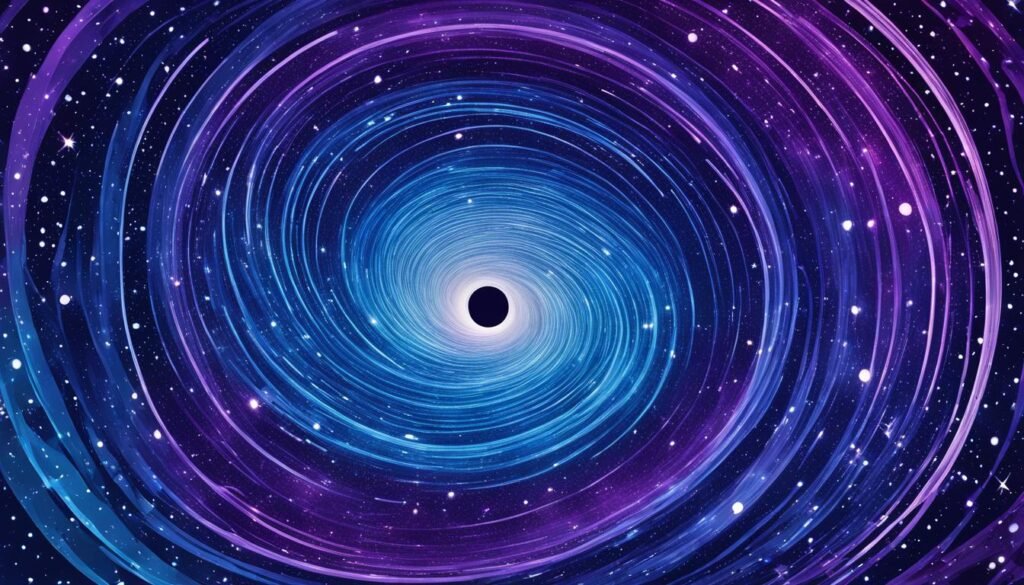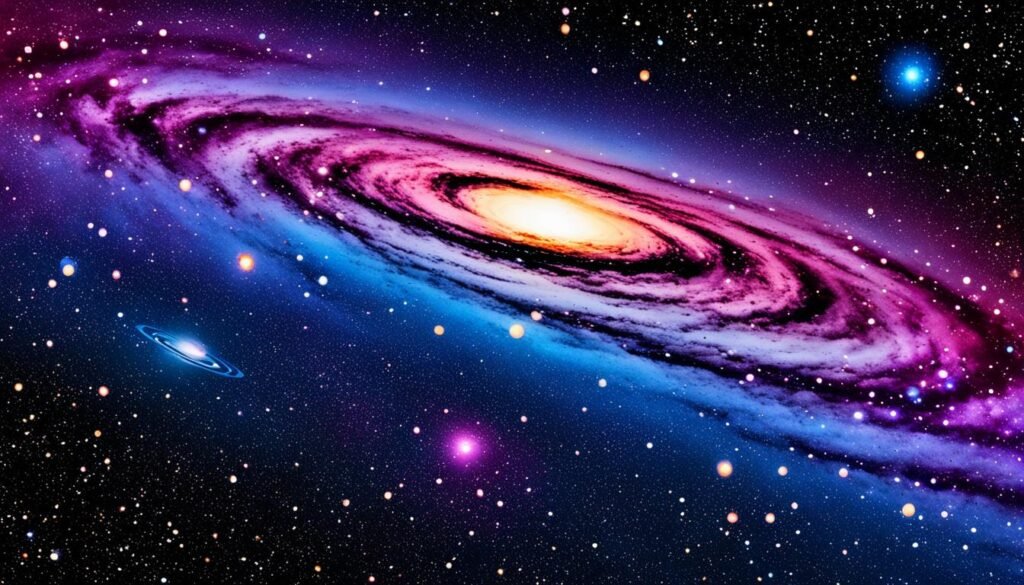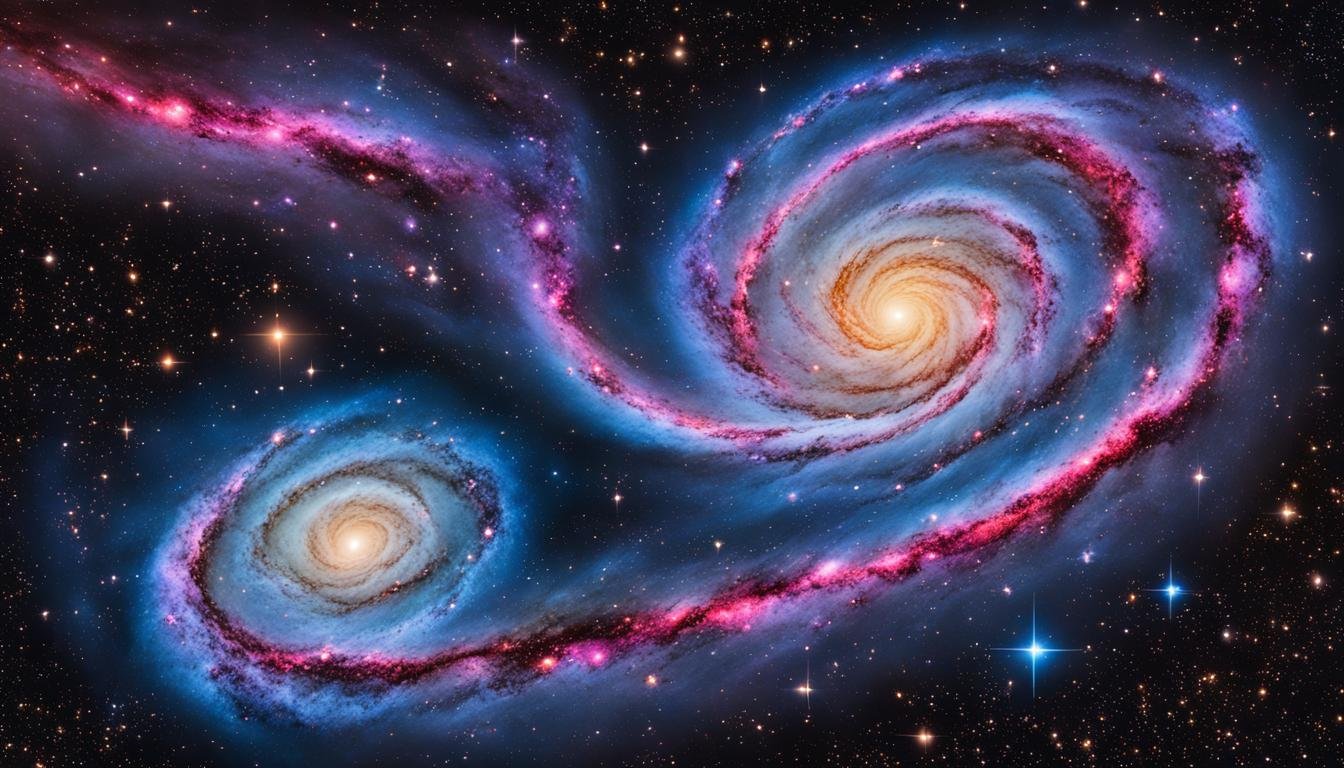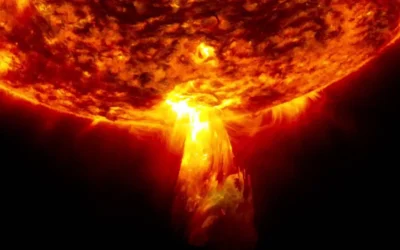As you peer into the night sky, the cosmos whispers ancient secrets of distant realms—a treasure trove of otherworldly marvels awaits your discovery. Among these celestial spectacles is Markarian’s Chain, a striking series of galaxies intricately woven into the heart of the Virgo Cluster. This eminent formation provides a captivating subject for deep-sky exploration, enchanting both seasoned astronomers and inquisitive amateur telescope enthusiasts alike. Here, we set our sights on the majesty of these stellar alignments, inviting you to unlock the mysteries of one of the universe’s most incredible vistas.
Key Takeaways
- Markarian’s Chain represents a serpentine layout of galaxies strewn across the Virgo Cluster, offering a cosmic voyage into celestial history.
- With an ordinary amateur telescope, you gain access to a microcosm of the universe within these celestial wonder.
- Deep-sky exploration of Markarian’s Chain challenges and expands our understanding of the intricate fabric of the cosmos.
- The collective movement of these galaxies captures the imagination, showcasing the grandeur of astronomical phenomena.
- Charting the Virgo Cluster’s star-filled expanse, one can expect to encounter the delicate interplay of light and darkness that defines our night sky.
- Observing Markarian’s eyes will reveal just a fraction of the diverse range of objects visible within this galaxy chain.
A Glimpse into the Virgo Cluster’s Heart: Markarians Chain Overview
As you dive deeper into the cosmos, you encounter the heart of the Virgo Cluster and its awe-inspiring Markarian’s Chain. This alignment of galaxies serves as more than just a feast for the eyes; it offers significant insight into the cosmic structure and the dynamics that govern our universe. Understanding the astronomical significance of the Markarian’s Chain galaxies unlocks a new level of appreciation for these deep-sky objects.
Understanding Markarians Chain’s Role in the Cosmos
The chain’s role as a major component of the Virgo Cluster’s architecture is astounding. Observing the Markarian Chain Overview through a lens, you grasp a clearer picture of the forces that sculpt the cosmic structure. Encompassing galaxies such as NGC 4477, NGC 4473, and NGC 4461 alongside the well-known M84 and M86, it represents the collaborative force of gravity and motion that defines our universe’s very fabric.
Observing Markarians Chain Through Amateur Telescopes
Your exploration of deep-sky objects doesn’t require professional-grade equipment. Amateurs can catch captivating views of the key members of Markarian’s Chain with a small telescope. For those who captivated by the wider Universe, larger telescopes can reveal the fainter members of this astronomical significance. The standout spectacle, known as Markarian’s Eyes, features the galactic dance of NGC 4438 and NGC 4435, highlighting the dramatic encounters in the Virgo Cluster heart.
| Galaxy Name | Classification | Approximate Distance (light-years) | Observation Notes |
|---|---|---|---|
| NGC 4477 | Barred Lenticular | 55 million | Visible with moderate equipment, possesses a bright core |
| NGC 4473 | Elliptical | 50 million | Distinguished by its elongated shape, a smaller telescope can reveal its form |
| NGC 4461 | Lenticular | 50 million | Fainter presence, best observed with larger telescopes |
| Markarian’s Eyes (NGC 4438 and NGC 4435) | Interacting Galaxies | 50 million | A small telescope unveils their proximity, giving the appearance of a pair of eyes |
The Stars of the Show: Key Galaxies in Markarians Chain
As you delve into the heart of the Virgo Cluster, you encounter the stars of the show—a series of key galaxies that form the spine of Markarian’s Chain. These celestial marvels, with their intricate details and colossal presences, are a testament to the majesty of the universe.
Notably, the duo of M84 and M86 stand out as luminous anchors, setting the scene for a deeper exploration into the richness of this galactic formation. Identified initially by that stargazing pioneer, Charles Messier, these lenticular galaxies, despite their subtle features, are anything but unremarkable in their influence on Markarian’s Chain.
Exploring the Bright Members: M84 and M86
Encountering M84, with its vast halo of hot gas, and M86, racing towards us at over 244 kilometers per second, your appreciation for these stars of the show is bound to deepen. They represent more than celestial waypoints; they are grand theaters of cosmic activity.
Markarian’s Eyes: The Interacting Galaxies NGC 4438 and NGC 4435
Yet the real drama unfolds with Markarian’s Eyes, the hypnotizing gaze of NGC 4438 and NGC 4435. Their gravitational pas de deux has left a lasting impression upon the canvas of space in the form of tidal tails and disrupted structures. This unique dance, a whisper of galactic encounters past, illustrates the dynamism of celestial evolution within Markarian’s Chain. As you peer through your telescope at these interacting galaxies, the narrative of cosmic forces and star formations is revealed in a way that captures both the imagination and the curiosity of onlookers.
Markarians Chain: A Discovery by Benjamin E. Markarian
When you delve into the cosmic enigma that is Markarian’s Chain, you unveil the legacy of Benjamin E. Markarian, an Armenian astrophysicist whose meticulous observations led to an extraordinary astronomical discovery. His work identified a series of galaxies, now known as Markarian galaxies, moving in a common motion across the expanse of space.
This groundbreaking revelation was more than an academic triumph; it was a pivotal moment that reshaped our comprehension of the Virgo Cluster’s dynamics. Markarian’s insight into the galaxy common motion of at least seven celestial members of the chain moving in harmony unveiled the intricate dance of the cosmos with profound clarity.
“Understanding the behavior of galaxies within such a structure as Markarian’s Chain is akin to decoding the DNA of the universe. Markarian’s findings are a testament to the relentless pursuit of knowledge that defines the spirit of astronomical inquiry.”
The astronomical discovery by Benjamin E. Markarian goes beyond mere observation. It encapsulates the connective forces that bind the galaxies together, providing essential clues to the gravitational relationships within Markarian’s Chain. This unity in motion signals the presence of underlying physical forces at play, shaping the formation and evolution of the Virgo Cluster and, by extension, the universe itself.
Below is a table highlighting key aspects of Markarian galaxies:
| Galaxy Name | Type | Distance (Million Light-years) | Common Motion Confirmation |
|---|---|---|---|
| M84 (NGC 4374) | Lenticular | ~53 | Yes |
| M86 (NGC 4406) | Lenticular | ~52 | Yes |
| NGC 4477 | Barred Lenticular | ~55 | Yes |
| NGC 4473 | Elliptical | ~46 | Yes |
| NGC 4461 | Lenticular | ~55 | Yes |
The Dynamic Motion: Understanding the Coherence in Markarians Chain
The captivating dance of galaxies within Markarian’s Chain is a stunning example of dynamic motion in the cosmos. As you delve into the workings of such galactic motion analysis, your understanding of the universe’s grandeur expands. Let’s explore the intricacies of this galaxy cluster dynamics and unveil the cosmic forces that maintain the coherence in Markarian’s Chain.
Moving as One: Analyzing the Galactic Motion
In the depths of space, the members of Markarian’s Chain exhibit an extraordinary display of orchestrated movement. It’s the pull of gravity—a fundamental cosmic force—that binds these galaxies together. This celestial choreography is guided by gravitational attraction, underpinning their shared velocity and path through the universe.

The Underlying Forces at Play Among the Galaxies
Gravitational forces are the key players in this vast, galactic game, steering the cohesive stride of Markarian’s Chain. To fully grasp the complexity of these interactions, consider the following comparison of various forces affecting both a component galaxy and the cluster as a whole:
| Force | Effect on a Single Galaxy | Effect on Galaxy Cluster |
|---|---|---|
| Gravitational Attraction | Maintains orbital cohesion around common center | Fosters the overarching structural integrity of the cluster |
| Dark Matter Presence | Augments gravitational pull beyond visible matter | Contributes to the overall mass and binding gravity of the cluster |
| Intragalactic Gases | Affects rotational dynamics and star formation | Acts as a medium for shock waves and energy transfer between galaxies |
| Galactic Collisions | Can significantly alter morphology and composition | Triggers cluster-wide responses and potential galaxy mergers |
Understanding these fundamental forces not only fosters a deeper appreciation for the grandeur of Markarian’s Chain but also for the concept of coherence that it represents within the vast expanse of our universe.
Location and Observation: Where to Find Markarian’s Chain in the Sky
As a budding or seasoned stargazer, your journey through the cosmos would be incomplete without a foray into observing Markarian’s Chain. To the uninitiated, this stunning array of galaxies can be found in the Virgo constellation, a realm that’s not only rich with celestial objects but also steeped in history and mythology. Pinpointing Markarian’s Chain location requires precision; therefore, understanding astronomical navigation is paramount.
Navigating the Constellations: Right Ascension and Declination
When you set out to observe Markarian galaxies, two key coordinates are your friends: right ascension (RA) and declination (Dec). Imagine these as the cosmic latitude and longitude guiding you to your destination. Markarian’s Chain sits at an RA of 12h 27m and Dec of +13° 10′. With these coordinates in mind, aligning your telescope becomes an exercise in celestial mechanics, transforming your stargazing into a navigational triumph.
Best Times and Equipment for Viewing Markarian’s Chain
To fully appreciate the grandeur of Markarian’s Chain, timing is everything. The chain makes its grandest appearance during the spring months when the Virgo Cluster claims its throne high in the night sky, offering the best viewing times. The faint glow of distant suns weaved within the chain is best revealed with the assistance of a suitable telescope. An 8-inch reflector suffices for most enthusiasts, while seasoned observers may employ more sophisticated equipment to unveil the subtler galaxies within the chain.
Your telescope observation experience hinges not only on the equipment but also on the conditions; thus, it is recommended to choose a clear, moonless night far from the intrusive lights of civilization. It is these moments, under the tranquility of a dark sky, that the cosmos unveils its silent poetry in the ballet of Markarian’s Chain.
A Closer Look at the Brightest Members of Markarians Chain
Delving into the depths of the cosmos, Markarian’s Chain offers a spectacular demonstration, showcasing the dance of galaxies across the night sky. An essential portion of this celestial procession includes its brightest members, known for their unique attributes and astronomical significance. The Markarian’s Chain explanation wouldn’t be complete without understanding the individual characteristics and contributions of notable galaxies such as NGC 4477, NGC 4473, and NGC 4461. Each one of these celestial entities provides a distinct piece of the cosmic puzzle that is the Virgo Cluster.
Your avid stargazing adventures might lead you to the barred lenticular Seyfert-2 galaxy known as NGC 4477, or the sheer elliptical elegance of NGC 4473, both resonating with the light of millions of stars from a distance of nearly 50 million light-years away. These two galaxies, along with NGC 4461—a gorgeously streamlined lenticular galaxy—serve as cornerstones of the luminous core of Markarian’s Chain.

To foster a deeper appreciation for these galactic marvels, let’s compare their vital statistics:
| Galaxy Name | Type | Visual Magnitude | Distance (million light-years) |
|---|---|---|---|
| NGC 4477 | Barred lenticular Seyfert-2 | 10.4 | Approx. 50 |
| NGC 4473 | Elliptical | 10.2 | Approx. 49 |
| NGC 4461 | Lenticular | 11.2 | Approx. 50 |
Whether you’re observing through the lens of a powerful telescope or studying data, the brightest members of Markarian’s Chain, such as NGC 4477, NGC 4473, and NGC 4461, provide not only a visual feast but also an endless source of scientific discovery. These galaxies allow us a peek into the grandeur of the universe, emphasizing the remarkable scale and diversity found within a single galaxy cluster.
Markarian’s Eyes: The Story of NGC 4435 and NGC 4438
When you explore the depths of space through the lens of deep-sky astronomy, few sights are as compelling as the interacting galaxies known as Markarian’s Eyes. These celestial neighbors, NGC 4435 and NGC 4438, offer a visual treat and an intriguing narrative set within the expansive canopy of the universe.
The close proximity of these galaxies not only makes them an impressive sight but also reveals the dynamic interactions that are a cornerstone of galactic evolution. Through your telescope, you can witness the remnants of a cosmic encounter that has captivated observers and astronomers alike—remnants which take on the appearance of vigilant cosmic sentinels.
Insight into NGC 4438 and NGC 4435 – often referred to as Markarian’s Eyes – is gained not just through their sheer visual brilliance but also via the stories they tell about the nature of our universe. These interacting galaxies have undergone a galactic performance so powerful that it has altered their structures and set the stage for a mesmerizing astronomical display.
Behold the interaction of NGC 4438 and NGC 4435, a spectacle that beautifully illustrates the tale of tidal forces at play, sculpting the galaxies into the watchful eyes that guard the Markarian’s Chain.
| Aspect | NGC 4435 | NGC 4438 |
|---|---|---|
| Type | Lenticular Galaxy | Spiral Galaxy |
| Interaction Evidence | Tidal Tails and Dust Rings | Distorted Arms and Gas Stripping |
| Visual Magnitude | 10.9 | 10.1 |
| Astronomical Highlights | Central Bulge, Possible Bar Structure | Active Galactic Nucleus, Star Formation Regions |
In embracing deep-sky astronomy, your journey through the cosmos grants you not just the sight, but the story of interacting galaxies like NGC 4438 and NGC 4435. Markarian’s Eyes act as a vivid reminder that our skies are not mere paintings but locations of profound narratives and ongoing celestial dialogues.
Discoveries Beyond Messier: The Hidden Gems of Markarian’s Chain
As astronomers and stargazers delve into the vastness of the cosmos, they are often reminded that the night sky is brimming with discoveries that remain unsung in the shadows of their more famous celestial counterparts. In the sprawling confines of the Virgo constellation, seasoned observers have recognized the brilliance of hidden gems that embellish Markarian’s Chain, a collection often outshone by the luminosity of its well-documented Messier galaxies.
These deep-sky gems, however, are no less significant. As you cast your gaze upon the Virgo constellation, seeking discoveries beyond Messier, you will encounter an array of glittering jewels that demand to be explored with eager eyes and telescopic lenses. Among this celestial array lies the NGC 4461 lenticular galaxy, a stunning tableau of starlight that punctuates the void with its unique presence.
Messier’s Lesser-Known Companions in the Galaxy Chain
Markarian’s Chain is not a lonely line of stars and gas; it is a family, its lesser-known members contributing to the collective gravitas of this space-bound lineage. The NGC galaxies, each with their own tale, encourage the curious to ponder and probe deeper into the nocturnal tapestry above.
The Curious Case of NGC 4461: A Lenticular Phenomenon
The enigmatic NGC 4461, a spectacle cataloged not once but twice due to various stages of discovery, is an exemplar of the sheer diversity the Chain offers. This lenticular galaxy, with its blend of spiral and elliptical properties, is a case study in the evolutionary pathways of galaxies, a literal crossroad in the cosmic journey of the night sky’s most magnificent objects.
| Galaxy | Type | Discovery | Magnitude |
|---|---|---|---|
| NGC 4461 | Lenticular | Independently cataloged twice | 11.2 |
| NGC 4479 | Lenticular | Discovered in late 18th century | 12.3 |
| NGC 4402 | Spiral | Identified in early 20th century | 12.6 |
Astronomical Significance: Why Markarians Chain Matters to Scientists
As a celestial connoisseur or an enthusiast of deep-sky marvels, your journey through the cosmos inevitably leads you to the Virgo Cluster, where Markarian’s Chain forms an essential part of the universal narrative. This sequence of galaxies does more than just decorate the night sky—it provides critical insights that aid scientists in deciphering the universe’s grand design. Understanding the astronomical significance of this chain is paramount, as it holds keys to unlocking mysteries about the shaping of the universe and the intricate mechanics of galaxy cluster dynamics.
Galactic Interactions and the Shaping of the Universe
In examining the relationships between galaxies within Markarian’s Chain, you encounter a stellar drama that illustrates the raw power and delicate balance of cosmic forces. The gravitational pull that choreographs the meeting of NGC 4435 and NGC 4438, along with the ensuing star formation in NGC 4388, showcases the pivotal events that drive galactic evolution. Such interactions are far from isolated incidents; they play a defining role in the shaping of the universe, contributing to the continuous change and development of galaxy structures over eons.
The Puzzle of Coherent Movement in Galaxy Clusters
Delving deeper into the structure of Markarian’s Chain, scientists unravel the enigma of the coherent movement puzzle. This concept, whereby galaxies within the chain demonstrate a shared motion through the vastness of space, poses fascinating questions regarding the gravity-driven dynamics within galaxy clusters. The distance of Markarian’s Chain from Earth allows you to witness these majestic movements in action, real-time displays of the forces at play within the vibrant and enigmatic Virgo Cluster galaxies. With each observation, you’re privy to the remarkable phenomena that define our cosmic neighborhood and possess the potential to alter our perceptions of the universe.
FAQ
What is Markarian’s Chain?
Markarian’s Chain is a string of galaxies found within the Virgo Cluster, notable for their intriguing arrangement and collective movement through space. This remarkable celestial feature is a target for both amateur and professional astronomers interested in deep-sky exploration.
How was Markarian’s Chain discovered?
The two brightest galaxies in the chain, M84 and M86, were first cataloged by Charles Messier in 1781. It was later in the 1960s that Armenian astrophysicist Benjamin E. Markarian discovered that these and other galaxies share a common motion through space, hence the name Markarian’s Chain.
Which galaxies are considered the main members of Markarian’s Chain?
Significant galaxies within Markarian’s Chain include M84 (NGC 4374), M86 (NGC 4406), as well as NGC 4438 and NGC 4435—collectively known as Markarian’s Eyes due to their visual appearance. There are also other galaxies like NGC 4477, NGC 4473, and NGC 4461 that are prominent members of the chain.
Why are NGC 4435 and NGC 4438 referred to as Markarian’s Eyes?
NGC 4435 and NGC 4438, two galaxies within Markarian’s Chain, are known as Markarian’s Eyes because, when observed through a small telescope, their close proximity and interaction create an appearance reminiscent of a pair of eyes watching the night sky.
What is unique about the movement of galaxies in Markarian’s Chain?
Markarian’s Chain is unique due to the coherent motion of at least seven of its galaxy members. They move through space at a common velocity, indicating a gravitational interconnection that contributes to the chain-like structure we observe from Earth.
How can one observe Markarian’s Chain?
To observe Markarian’s Chain, one would typically need an 8-inch reflector or larger telescope. The optimal viewing period is during the spring months when the Virgo Cluster is high in the night sky. It’s advised to locate the chain using its Right Ascension and Declination for precise navigation.
Where is Markarian’s Chain located in the night sky?
Markarian’s Chain is situated within the Virgo constellation, with a Right Ascension (RA) of 12h 27m and a Declination (Dec) of +13° 10′. This makes it relatively easy to find for those who are familiar with astronomical navigation techniques.
What is the astronomical significance of studying Markarian’s Chain?
Studying Markarian’s Chain provides valuable insights into the dynamics of galaxy clusters, the gravitational forces at play among galaxies, and the processes that shape our universe. The movements and interactions among the galaxies in the chain, such as those between NGC 4435 and NGC 4438, are of particular interest to astronomers who seek to understand galactic evolution.
What are some of the lesser-known galaxies in Markarian’s Chain?
Beyond the well-known Messier galaxies, Markarian’s Chain includes several other noteworthy galaxies, like NGC 4479, a faint lenticular galaxy, and NGC 4402, a spiral galaxy with a prominent dust disc. NGC 4461, also part of the chain, is a lenticular galaxy that captivates astronomers due to its unique features and history.
How does the study of Markarian’s Chain contribute to our understanding of galaxy clusters?
The study of Markarian’s Chain helps astronomers understand the gravitational interactions that govern the behavior and evolution of galaxy clusters. By unraveling the coherent movement and dynamics of the chain’s galaxies, scientists gain a deeper comprehension of the large-scale structure of the cosmos.






